Out of all the things I was most excited about in South America, hiking the Inca trail was number one. This isn’t original. As Peru’s most popular tourist attraction, Machu Picchu has around 1.2 million visitors a year, although most of these get the train up from the nearby town of Agua Calientes.
But for many backpackers, trekking to Machu Picchu is the only way to get there. There are several different treks you can do: some involve activities like zip-lining, others take you on paths far less travelled. Almost all are much cheaper than the Inca trail, for which prices start at around $550 – and you end up paying a lot more than that in total.
But the classic four day Inca trail was the only option for me. Ever since I received a copy of The Incredible Incas in my Christmas stocking as a child, I’d wanted to do it – to literally follow in the footsteps of the Incas, along the roads that they’d laid and past villages they’d built.
The trail takes you along 27 miles of ancient pathways, past several archaeological sites and the most spectacular scenery you can imagine. With a peak altitude of 4,250 metres or 13,779 ft (for context, you skydive from 12,000 ft) there are breathlessly high peaks and painfully steep descents as you trek through mist-cloaked cloud forests, overgrown valleys and barren mountain peaks.
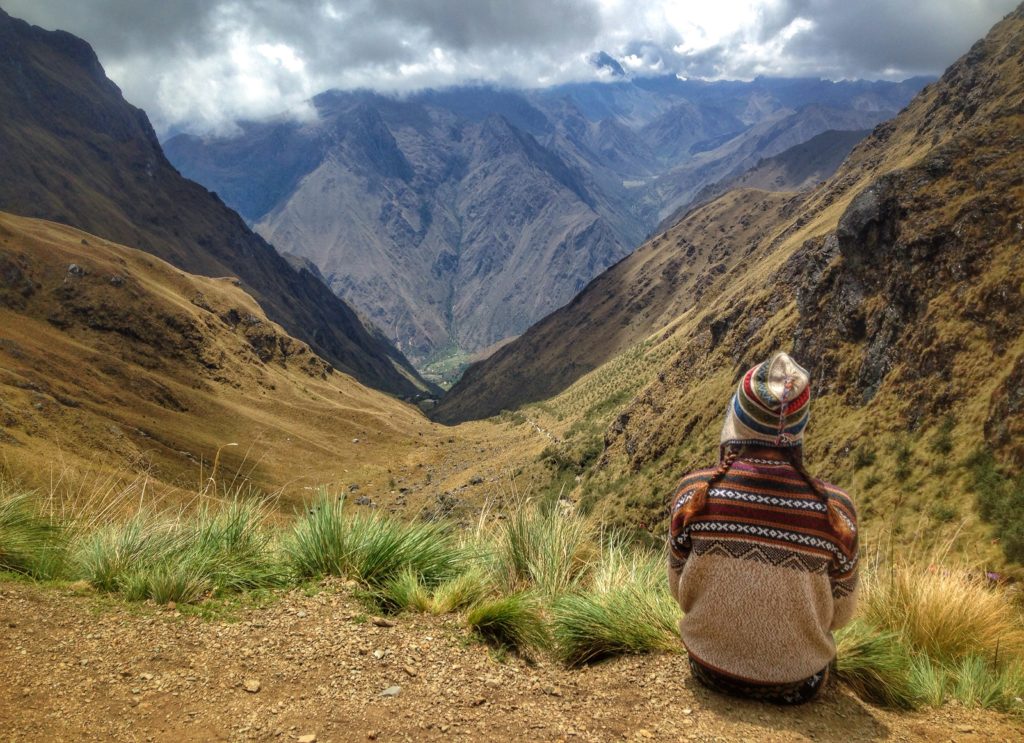
You can only do the tour with an authorised company, and after months of obsessive research, I decided on Llama Path. At $650, they’re more expensive than others, but there are reasons for this which I’ll get to. On top of that there are (optional) services you pay for, some non-included fees and, of course, the kit you need to buy. In total, it came to just under $1000 each. So, not cheap.
If you’re on a budget, it can be tempting to do one of the cheaper treks, or even just get the train up to Machu Picchu in the morning. And I did consider this. For months I questioned whether I should do it. Could it really be as incredible as people say? I’m not fit; will I even be able to complete the trek? With climbs of over 4,250 metres, will I get altitude sickness? And is it, honestly, worth all the hype?
The answer to all four questions is ‘yes’, but the trek was both more gruelling and rewarding than I could have ever anticipated. Here’s the truth about hiking the Inca trail.
Inca Trail Day One: Wayllabamba to Ayapata
After meeting our group the night before and spending a few days in Cusco to acclimatise to the altitude, the day began with a 3:45am start. To say I’m not a morning person is an understatement, but we had to meet our tour group at 4:30am, so needs must. We boarded the bus, me with my travel pillow in tow, and headed to km 82 in Ollantaytambo where the hike begins.
Aside from the other trekkers we also had about 15 porters with us, who carry the tents, food, camping equipment and, if you choose, up to 7kg of your kit. I’d read enough reviews to know that this was strongly advised, and so both Tom and I paid an extra $75 dollars each for that service. The porters carried our sleeping bags and extra clothes, we carried our day packs. When you’re hiking all day through rough terrain and high altitudes, you appreciate carrying a little less weight.
After a quick stop for breakfast at a small restaurant we passed through the official checkpoint, had our passports stamped, posed for a quick group photo, and then we were off.
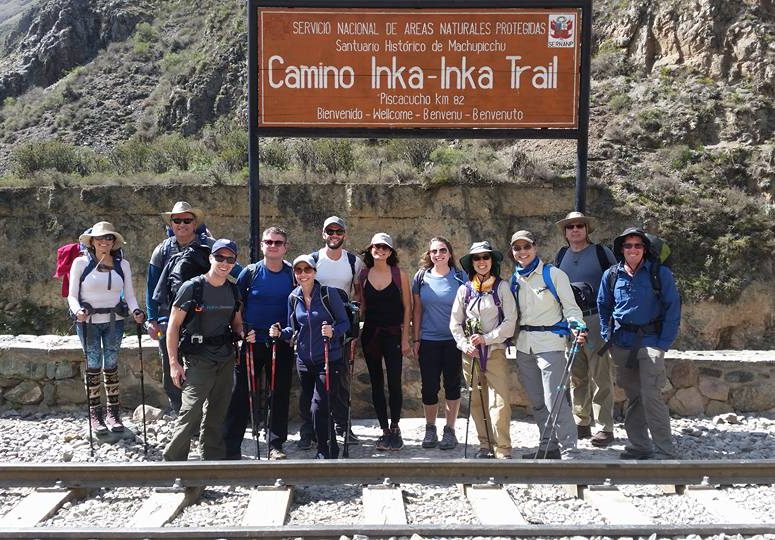
The trek began gently, with a wide path meandering through the Sacred Valley and crisscrossing the Urubamba River. Though in hindsight day one probably provided the least impressive scenery, it was still genuinely magnificent. The sheer scale of these mountains was startling, and it wasn’t hard to understand why the Incas used to view them as gods.
We’d been in the South American mountains earlier on this trip, when we visited Colombia’s Sierra Nevada mountain range. But this was like nowhere else. Instead of tropical valleys and wooded mountains, the landscape was harsher, wilder, at times even bleak. But to me, it was even more beautiful. Stunted bushes rose out of scrawls of grass, inca ruins still crouched on grudging soil; it all felt like archetypal ‘South America’, more so than anywhere else we’d been.
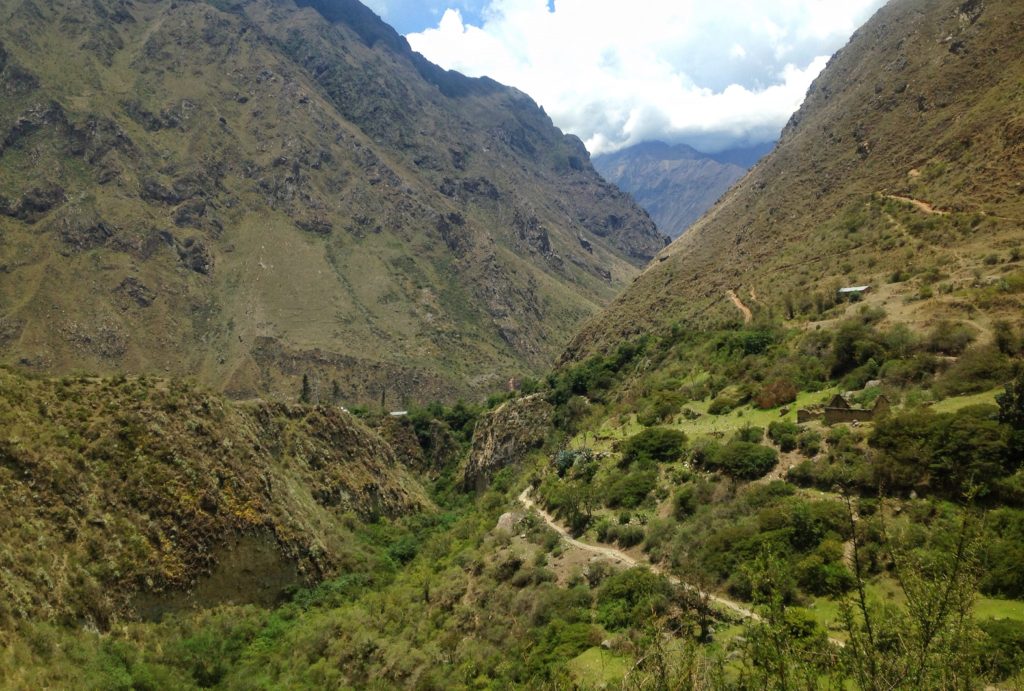
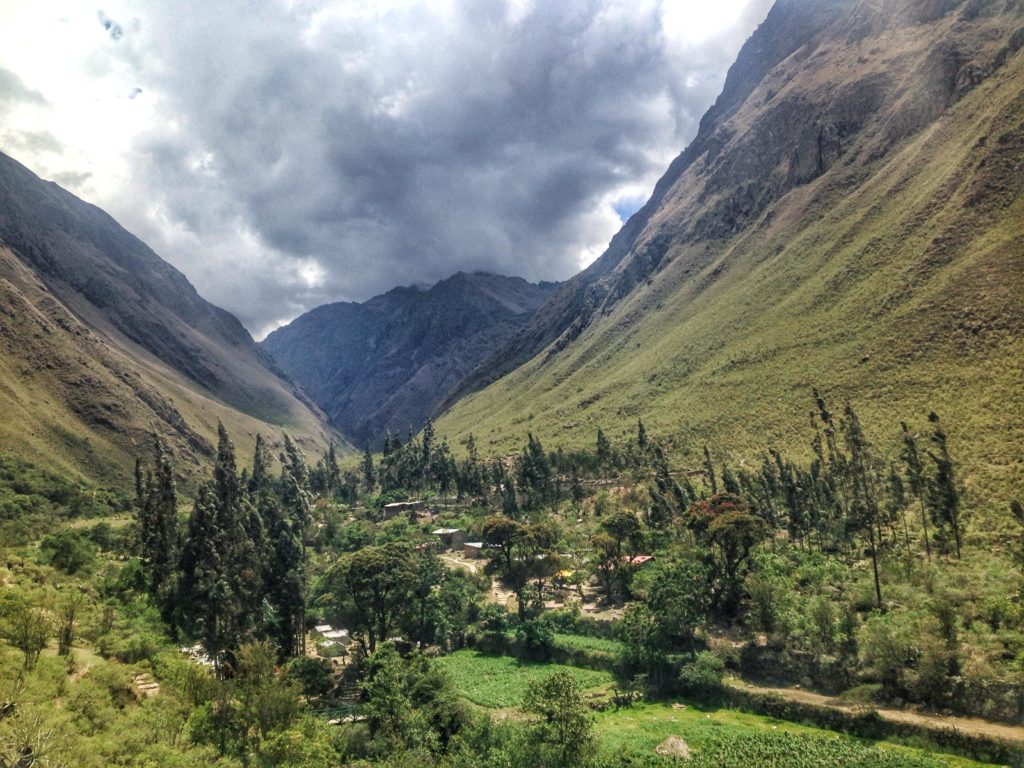
The route took us past Wayllabamba, the first of many ruined Incan civilisations we’d pass on the way, and our guides explained their history and purpose. Charlie and ‘Happy’ (it was the translation of his surname!) were genuinely passionate about the Incan history and proud of their ancestry, repeatedly referring to the Incas as “my ancestors”, which Tom and I really liked.
The earlier part of the trail is known as the ‘Inca Flat’, but in the afternoon it was uphill all the way. It was at this point we lost two of our team members, who were struggling with cramp and had to turn back. Even at this early starting point we were 3,000 metres above sea level, and any lungs unused to height will struggle for breath in the thin air. I did better than I thought in terms of stamina, but then again, as the youngest member of the group I didn’t really have any excuses.
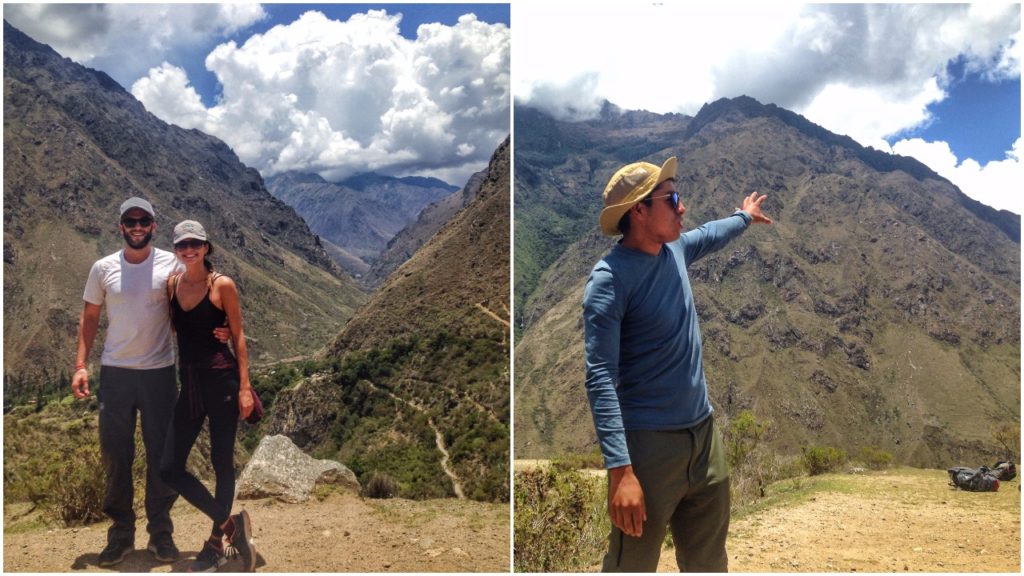
Tom and I looking perky on day one; our guide Happy telling us about the Inca site Wayllabamba.
Our team broke off into groups based on pace: at the front was Craig, an expert Aussie trekker, Tom and me, Lindsay, a lovely American girl around our age, and Martyn, a fellow Brit. We couldn’t have been luckier with our group. I was dreading being teamed with a bunch of back-slapping, high-fiving gap years kids, but everyone was so nice and added something to our group dynamic.
Lunch was the first point I knew going with Llama Path was the right choice. I’d read reviews about how good the food was, but I think it’s fair to say our entire group was dumbfounded by how well we ate. We arrived at the lunch stop to find that the porters had already erected the dining tent and laid out little bowls of water for us to wash our hands in. What followed was a delicious four-course lunch: ceviche (veggie for me!), soup, vegetables, cheese, rice, avocado… It was incredible.
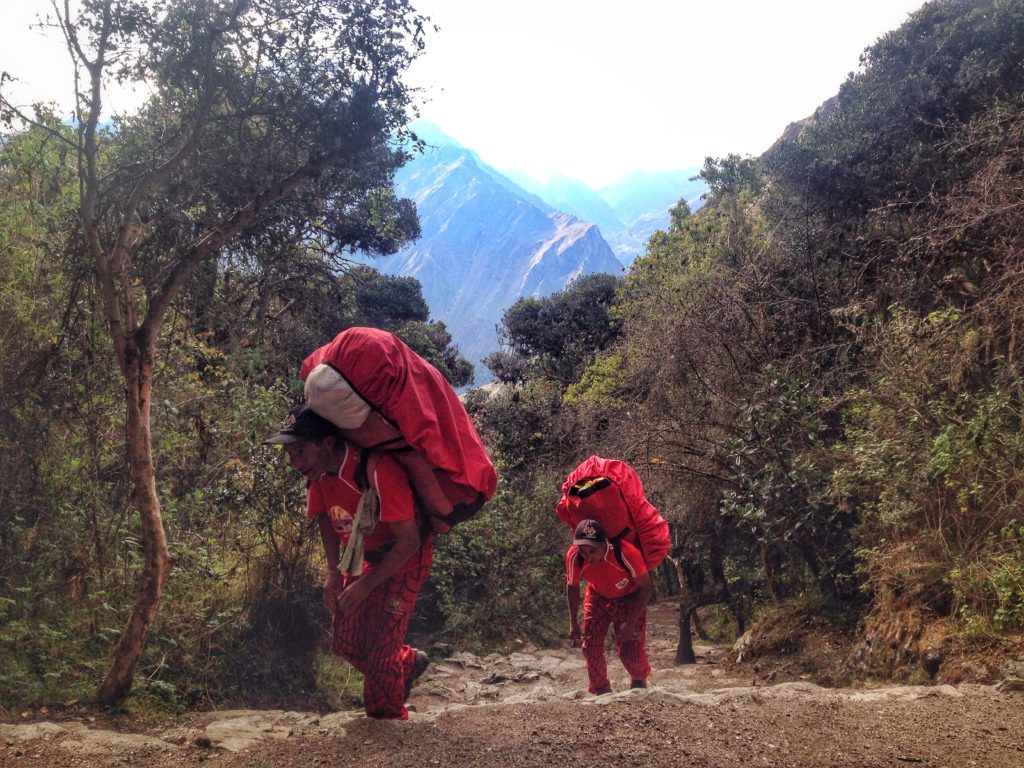
How the porters throw together meals like this with only camping equipment is beyond me – these guys were seriously amazing. In spite of the bulk on their backs, they stormed up and down mountains like supermen (in appropriately jazzy Spiderman trousers), overtaking us quickly and effortlessly. And this is another reason to pay a little extra for Llama Path, because mistreatment of porters on the Inca trail has been rife for decades.

Llama Path were the first company to establish strict ethical guidelines: their porters are provided with accommodation, proper uniforms and equipment, a fair and legal wage and medical insurance. They’re also only allowed to carry a maximum of 20kg in their packs. Some of the porters from other Inca trail companies (many of whom were in sandals and seemed to be well into their 50s) looked like they were carrying twice their body weight.
We arrived at camp around 5pm and flopped into our tents. At 6pm we had ‘happy hour’ (hot chocolate, biscuits and popcorn!) and then an enormous dinner was served an hour later. You might think that eating so well is an unnecessary luxury on a trek, but to me it’s so worth paying a slightly higher price for. When you’re hiking 11 hours a day, the food becomes what you look forward to most. Knowing a decent dinner is waiting can literally propel you up a hill.

After dinner our guides explained (somewhat gleefully) about just how difficult day two would be. We’d be awoken at 5am in order to begin the relentless uphill slug to the peak of the delightfully-named Dead Woman’s Pass. At 4,250m, Dead Woman’s Pass is the highest point of the trek – four times the height of Mt Snowdon in the UK. It’s also the point where most people succumb to altitude sickness. With those thoughts whirling in our heads, we retired to our tents and to bed.
Inca Trail Day Two: Dead Woman’s Pass
Day two began pretty well. Considering I find it almost impossible to fall asleep before midnight, I didn’t feel too bad at the early start. It definitely helps, when you crawl blearily out of your tent at five in the morning, to be greeted with hot coca tea from the porters, and this view of the Andes.
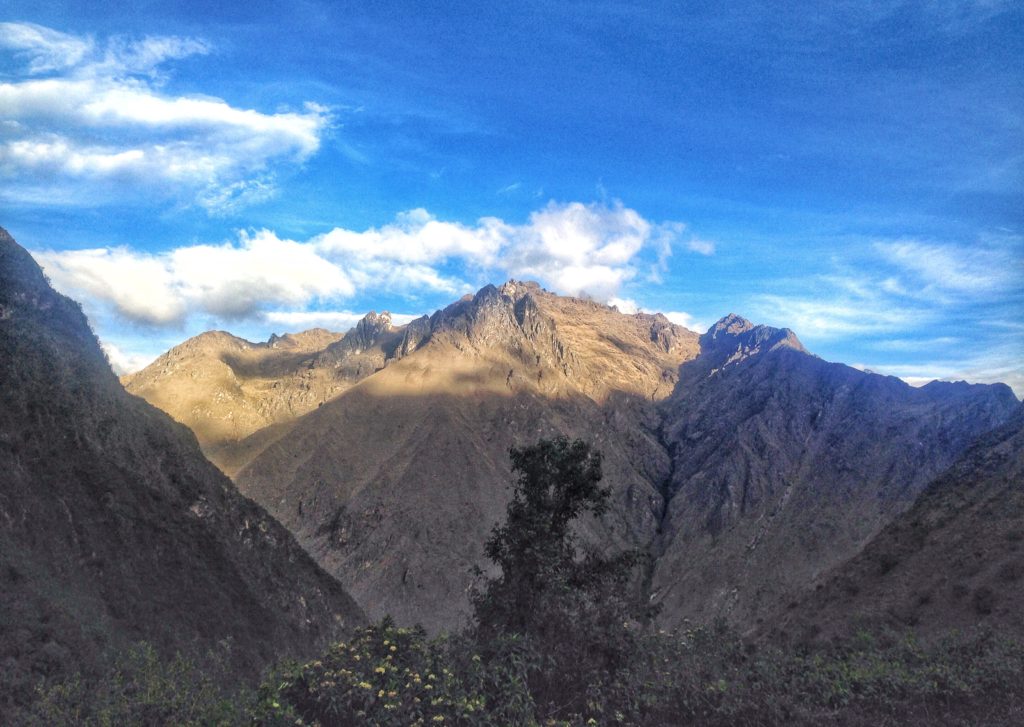
After a delicious and filling breakfast, we began the unforgiving ascent. Though the days can be extremely hot in Peru, the nights and early mornings are freezing. We began bundled up in fleeces, jumpers, hats and gloves, slowly shedding garments as we climbed. It was hard. The higher we got the harder it became to breathe, and after a while we got out the coca leaves.
Coca leaves have been chewed for centuries among the indigenous people in the Andean region, and were widely used by the Incas. Coca leaves rather notoriously form the natural ingredient within cocaine, but in their raw, natural form they act as a very mild stimulant, suppressing hunger, thirst, pain and tiredness. They also help overcome altitude sickness, so most trekking companies recommend bringing some leaves or some coca sweets with you on the trek.

We had a quick break halfway up the mountain where we stopped to take pictures, but even with the coca leaves the ascent was pretty brutal. Climbing up a steep mountainside for five hours straight isn’t easy, but it wasn’t until the last half hour or so that I really started feeling the effects of the altitude. A sudden, strong bout of nausea hit me and I had to spit out the leaves I was chewing to stop myself being sick. With Tom now sweetly carrying my bag, we made up to the top.
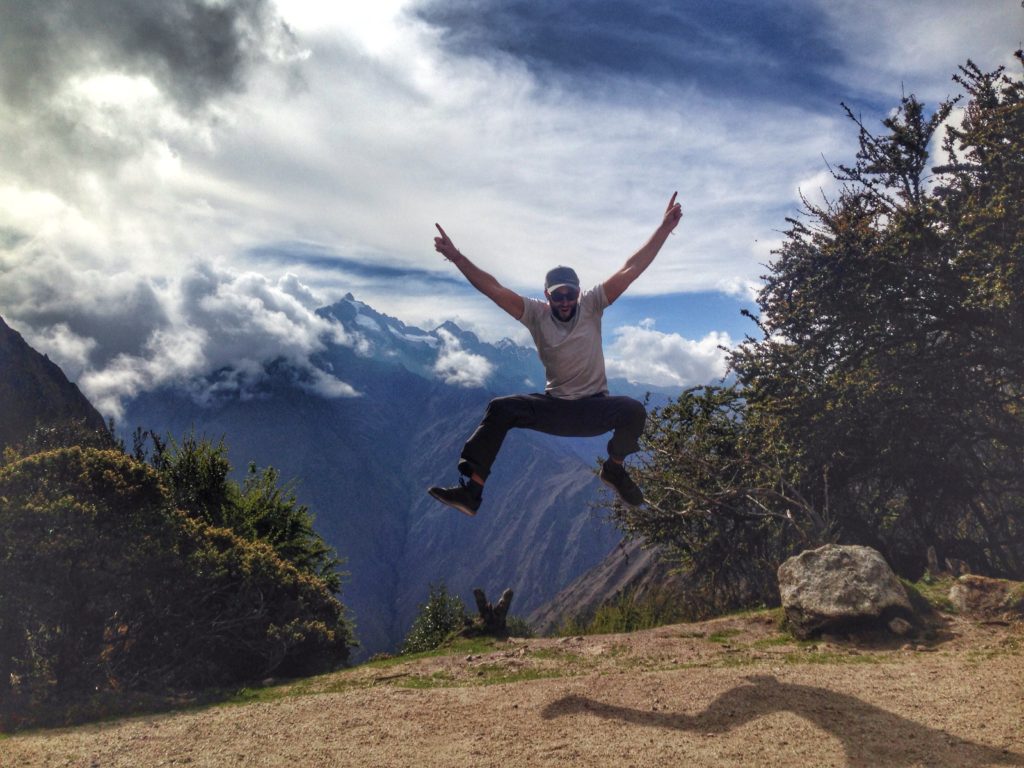
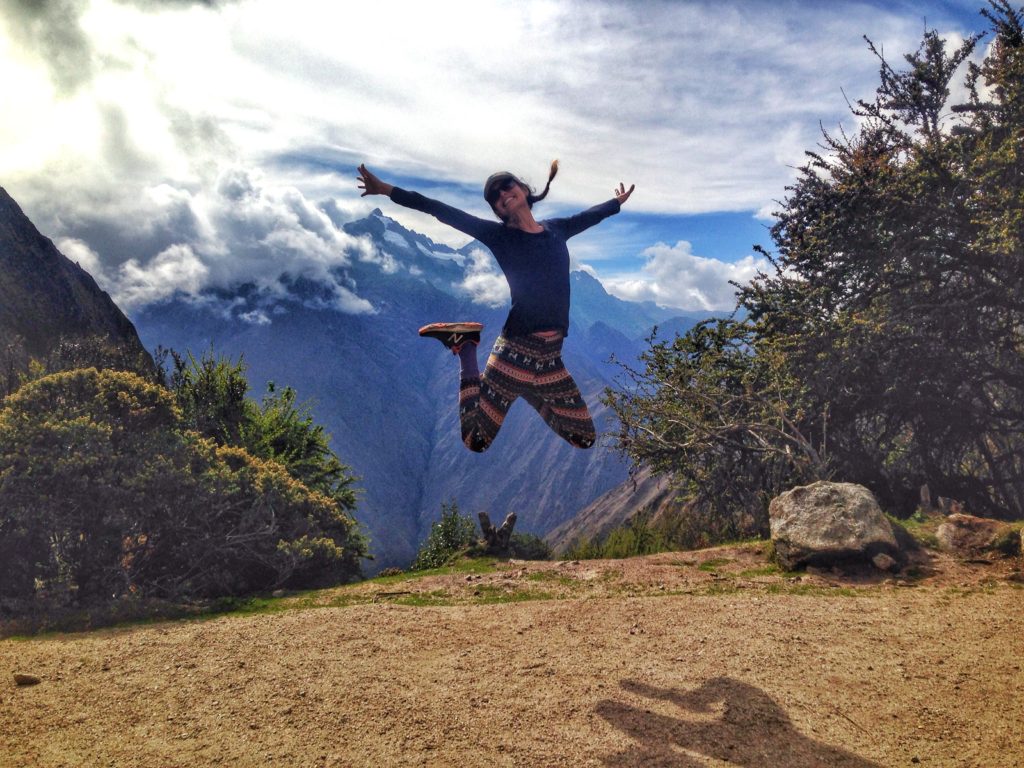
The halfway point of Dead Womans Pass, when my legs still possessed the ability to jump.
Now I’m not the overly sentimental type, but the relief of scaling Dead Woman’s Pass was so strong, and the views so incredible, that I’m not ashamed to admit I felt a little emotional. I’d never been so high in my life, nor seen views so breathtaking, and it gave me a new lease of energy. From that height you feel huge. It may be a struggle to breathe against the cold, bone-dry wind, but the eyes stride like giants over this starkly beautiful land.
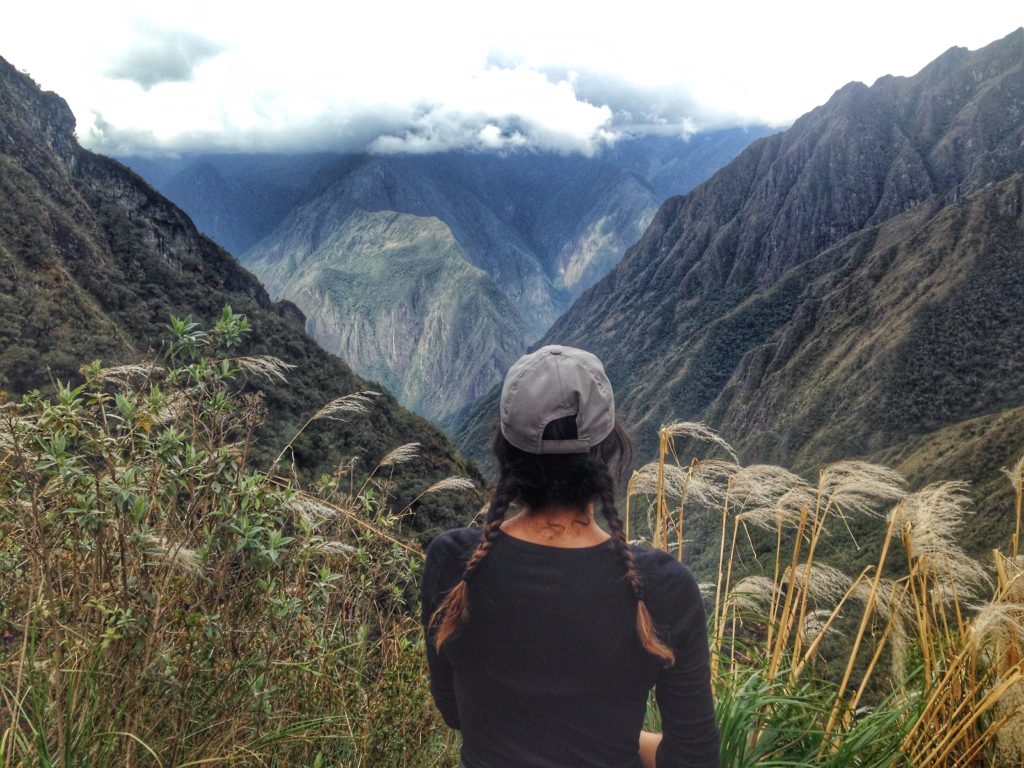

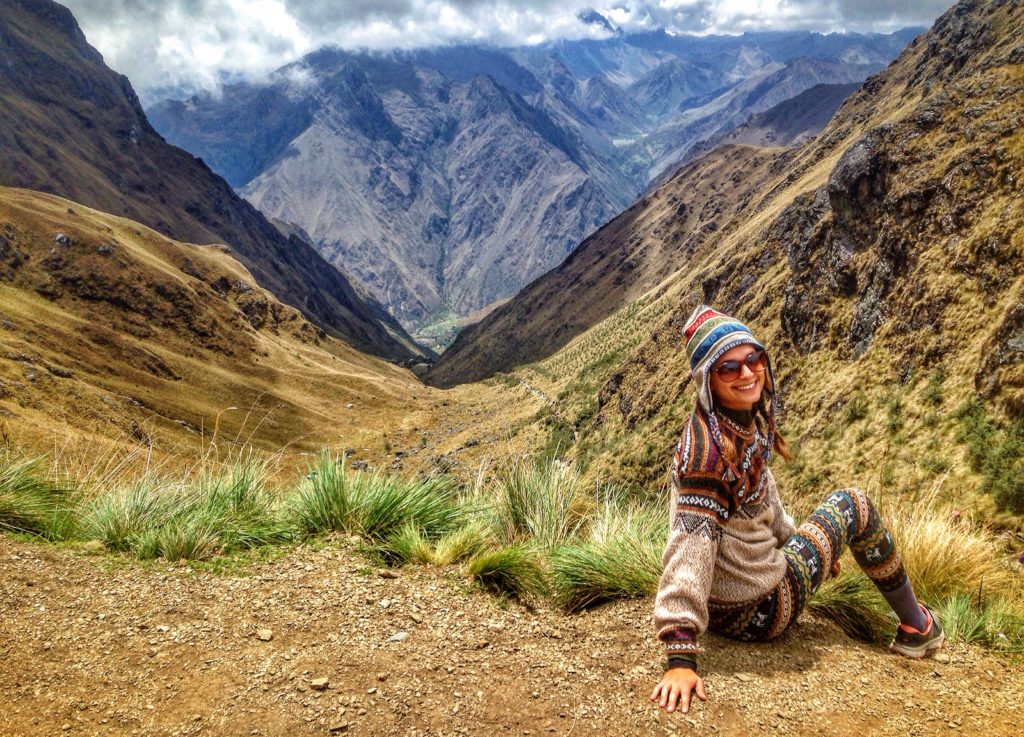
I may have gone a little overboard with the Peruvian inspired outfits…
“The hardest part is over,” our guides told us, and this is what I’d read countless times: once you’re over Dead Woman’s Pass, the hard part is over. I’m going to strongly disagree with this. For me, ascents are so much easier than descents. They’re harder in that you have to stop to catch your breath, but they’re relatively painless. In the moment, anyway (by the afternoon my thighs were screaming). But descents are something else.
I’d never had cause to walk down thousands of ancient steps before, so I didn’t know just how badly that can hurt. But oh my god my knees. At this point I was so glad I hired walking poles. They were totally invaluable on day two. After about an hour of non-stop stepping down, my knees began to shake uncontrollably. At one point they gave out entirely and I landed roughly on my bum. Descents, it turns out, are not so fun…
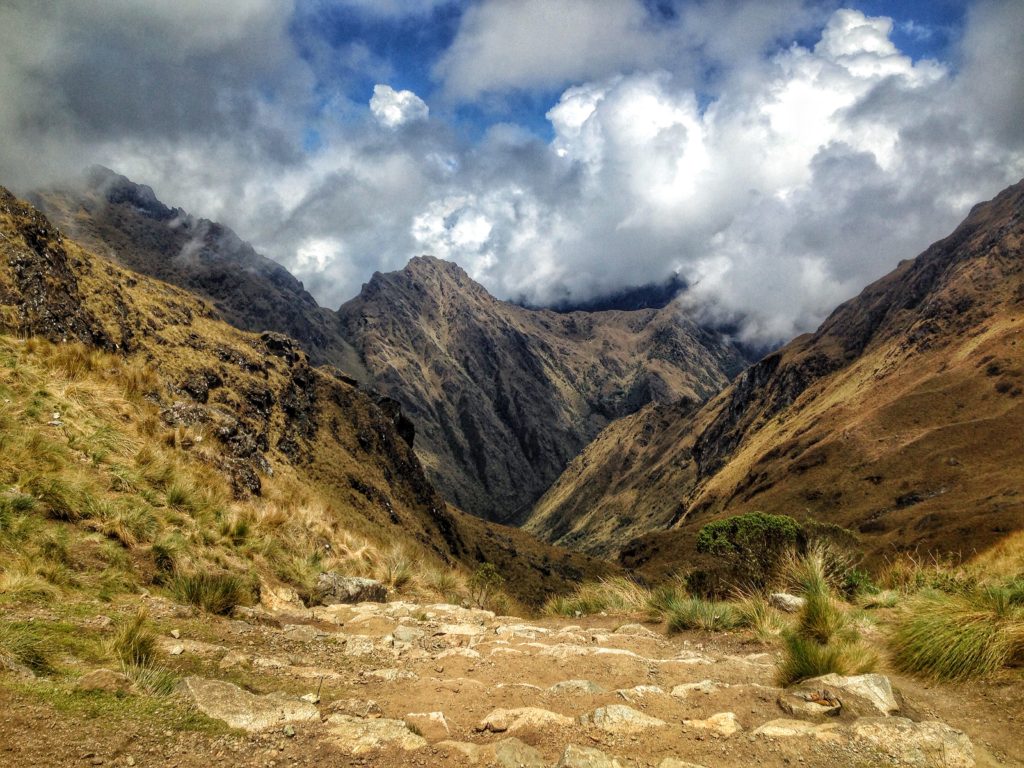

Getting good use out of the walking poles…
After about two hours of climbing down to 3,580 metres (11,700 ft), we stopped for lunch. At this point, most of us were already sore – with the exception of Craig, who was like bionic man. It was hard to relax knowing that we had another heart-pounding climb to 4,000 metres (13,123 ft) that afternoon – and of course, another painful descent to 3,600 metres (11,800 ft) after that. The phrase “It’s all downhill from here!” will always strike fear into me now.
Still, despite my sore, shaking knees and aching calves and thighs, I could appreciate the panorama. There aren’t enough superlatives to adequately convey how beautiful this part of the world is, and I definitely don’t possess the writing skills to try. But it was genuinely awe-inspiring. There was something wonderful about knowing that the landscape had barely changed from when the Incas trod the same path around 500 years before.

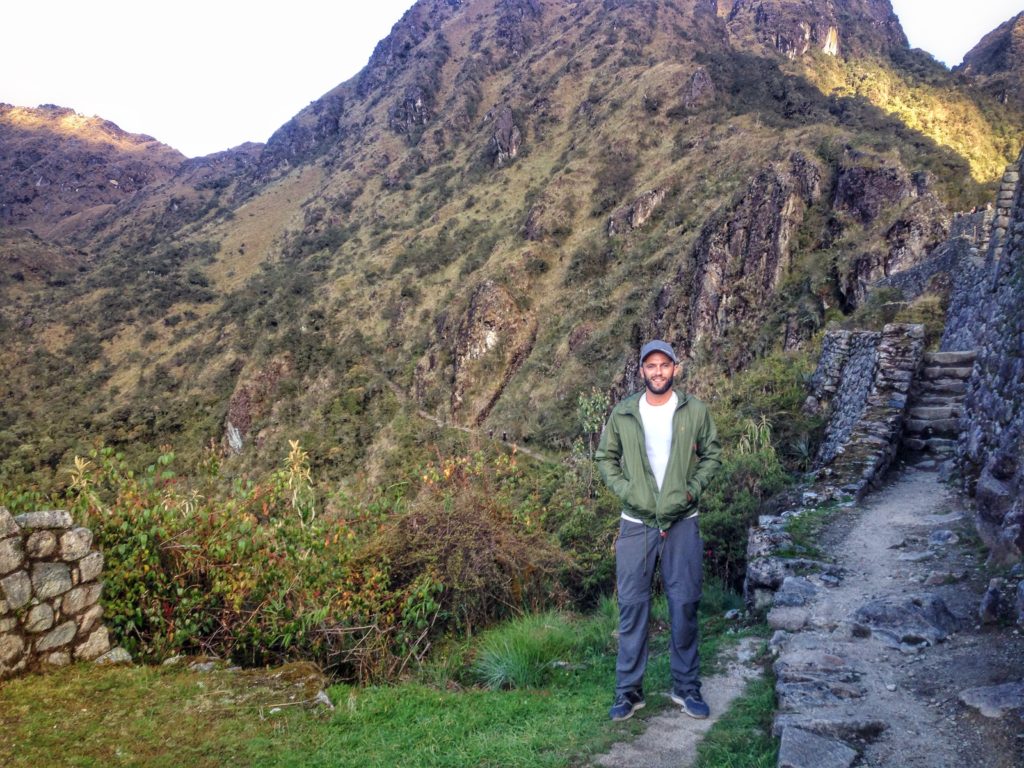
Before the day was out we explored another beautiful Incan ruin on a hilltop, and then I managed to drag myself to camp. We were all tired and sore, but spirits were high. Day three was meant to be the most enjoyable day, and at this point, the hardest part of the Inca trail really was over.
Or so I thought.


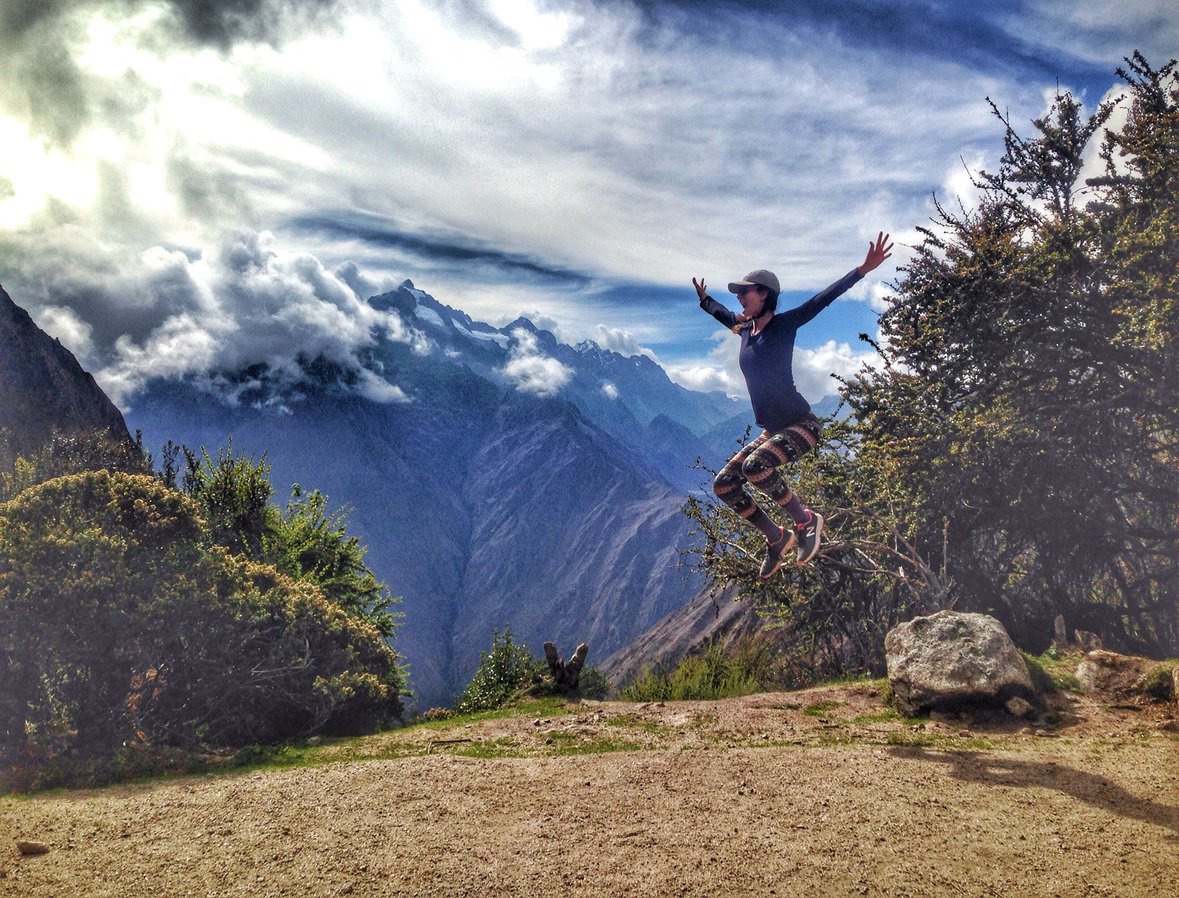

One Comment